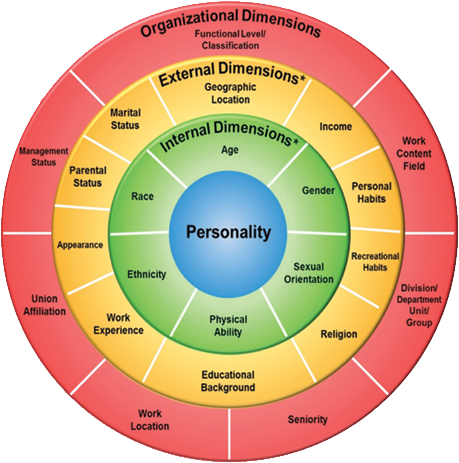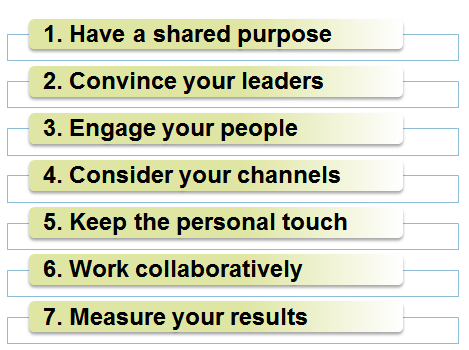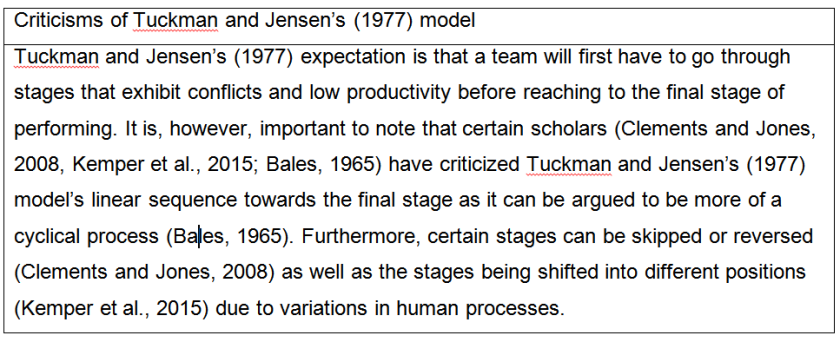The Challenge of Managing a Diverse Team
Research has established a direct relationship between diversity and increased efficiency amongst teams, provided that the teams have been led well by their leaders (Ibarra and Hansen, 2011). Differences in backgrounds, cultures, generations can pool in and foster a great deal of creativity and fulfillment at the workplace. However, it may also cause a concern when certain clashes between individual differences arise. This is when a leader should step in, with his or her abilities to empower people to collaborate with each other (Mullins, 2010) and leverage what they have to offer (Ibarra and Hansen, 2011). In order to understand these cultural and personal differences of people, leaders should be aware of the dimensions of diversity which can be explained by the Gardenswartz and Rowe’s (2003) Diversity Wheel.
Dimensions of Diversity
There are already many studies that have successfully created simplified methods to measure an individual’s personality, the Diversity Wheel by Gardenswartz and Rowe (2003) is one of the few that illustrates the complexity of what creates and influences an individual’s unique personality (see figure 1). Understanding the internal, external and organizational dimensions shaping an employee’s personality may assist a manager in maximizing their full potential and provide with them with a feeling of fulfillment.
Figure 1: The Diversity Wheel by Gardenswartz & Rowe (2003)

Group Development
Llopis (2012) is amongst other researchers who emphasized the importance for leader to having the ability to build a team by learning and maneuvering his or her pupils’ unique skills and strengths to achieve overall organizational efficiency. Therefore, it is important for a manager to be familiar with stages of team formation as outlined by Tuckman and Jensen’s (1977) in their Stages of Group Development (Figure 2). The model discusses the four consecutive stages that lead to team formation which are: Forming, Storming, Norming and Performing. To learn more about these stages, please watch this video.
Figure 2: Tuckman and Jensen’s (1965) Stages of Group Development Model

Advantages and Limitations of Diversity Management
Managing and fostering diverse teams have been researched to provide organisations with increased productivity, employee satisfaction, cross-team learning, creativity and profitability (Mullins, 2010). A good example of a company earning these benefits is Google Inc. as they have taken an enormous interest in harnessing the creativity and collaborations of diverse programmers across the globe. Google Inc. is utilizing their interest in workforce diversity as an opportunity and strategy to gain competitive advantage over their competitors and there is research (Hunt et al., 2014) that has proven that higher workforce diversity provides companies with competitive advantage.
However, if managers are unable to manage culturally diverse teams, it will be problematic to almost all stakeholders of an organisation. Firstly, misunderstanding the differences in cultural values may lead to low morale levels as managers are not able to apply the right motivation techniques for the right person (Majlergaard, 2012). Secondly, if a firm does not invest in workforce diversity, such as diversity training programs, then the firm will forgo the opportunity in noticing overachieving minorities or diverse employees that should be earning an opportunity to be promoted or at least rewarded. Finally, the main challenge that may occur during diversity management is discrimination amongst employees. Research (Conner, 2015) suggest that over 30 % of women still feel that men are offered better work opportunities and promotions than them. It is important factor to consider as discrimination and stereotyping have been found to cause direct harm to a firm’s reputation, working relationships, productivity and overall employee satisfaction and morale (Green et al., 2015).
Managing a Diverse Team as a Skill
Since I am aiming to enter the entertainment industry, managing a diverse team is one of the most significant skills. In the entertainment industry, advertising projects are done in a regular basis in order to attract viewers from across the world. A small film studio based in the US can advertise a film that is almost guaranteed to be watched by an individual from a different continent. Therefore, it is required to hire and pool in ideas from diverse individuals in order to stay creative as well as to stay globally aware of cultural differences when designing marketing communication tactics. A practical example is CBS Entertainment, an entertainment firm that has designated a sole department to hire diverse talents (see figure 3) across the US (Porter, 2017).
Figure 3- CBS Diverse Talent Search (Source: CBSCorporation.com)

In order to my team work together effectively I would follow the steps illustrated in the picture below.

References
Bales, R. F. (1965) ‘The equilibrium problem in small groups’ in A. P. Hare, E. F. Borgatta and R. F.
Clements, P. and Jones, J. (2008). The Diversity Training Handbook. 1st ed. London [u.a.]: Kogan Page.
Conor, L. (2015) A Third Of Working Women Say They’re Discriminated Against [online] available from <https://www.theguardian.com/women-in-leadership/2015/jun/03/third-of-working-women-discriminated-against> [Accessed 5 Mar. 2017]
Gardenswartz, L. & Rowe, A. (2003). Four layers of diversity. Retrieved from http://www.gardenswartzrowe.com/why-g-r
Green, K., Clark, J., Lopez, M., Farnsworth, D., Kepner, A. and Wysocki, J. (2016)Diversity In The Workplace: Bene Ts, Challenges, And The Required Managerial Tools [online] 1st edn. Florida: University of Florida. available from <https://edis.ifas.ufl.edu/pdffiles/HR/HR02200.pdf> [Accessed 5 Mar. 2017]
Hunt V., Layton D. and Prince S. (2014) ‘Why Diversity Matters’ [online] available from:<http://www.mckinsey.com/business-functions/organization/our-insights/why-diversity-matters> [Accessed 5 Mar. 2017]
Kemper L. E., Bader A. K. and Froese F. J. (2015) ‘Diversity Management in AgeingSocieties. A comparative study of Germany and Japan’, Management Revue. 27(1-2), 29-49 [online] available from: <http://web.a.ebscohost.com.ezproxy.inti.edu.my:2048/ehost/pdfviewer/pdfviewer?sid=b05d97b9-53a0-4e6e-9f8c-321cb21275c2%40sessionmgr4009&vid=1&hid=4204> [Accessed 5 Mar. 2017].
Llopis G. (2011) ‘Diversity Management Is the Key to Growth: Make It Authentic’Forbes Leadership [online] available from: <http://www.forbes.com/sites/glennllopis/2011/06/13/diversity-management-is-the-key-to-growth-make-it-authentic/2/#32a84c8d6646> [Accessed 5 Mar. 2017].
Majlergaard, F. (2012) The Top 5 Challenges Managers Of Cultural Diverse TeamsAre Facing – Gugin [online] available from <http://gugin.com/the-top-5-challenges-managers-of-cultural-diverse-teams-are-facing/> [Accessed 5 Mar. 2017]
Mullins L. J. (2010:157-162) ‘Management and Organizational Behaviour’. Ninth Edn. Edinburgh Gate: Pearson Education Ltd.
Porter, J. (2017). Meet the CBS Executive Who’s Bringing Diversity to TV. [online] TIME.com. Available at: http://time.com/collection-post/4596947/tiffany-smith-anoai-american-voices/ [Accessed 5 Mar. 2017].
Tuckman, B. W. and Jensen, M. A. (1977) Stages in small group development revisited. Group and Organisation Studies 2; pp. 419-427.


hi
LikeLike
Should diversity concern the culture?
LikeLike
Of course, Mr. Yang!
A big component of what makes diversity is the culture and ethnic background of each individual. These factors are considered within the internal dimensions within the Diversity Wheel illustrated in my blog above. Some individuals are motivated with more free days to spend time with family rather than just getting an increase in payment solely. This is mainly due to their cultural background being more collective rather than individualistic. These characteristics is usually displayed in South American, Asian and Middle Eastern countries.
LikeLike
Is that difficult to work in the diversity culture in the international company.
LikeLike
It depends on the person. If a person has and/or wants experience working with diverse teams, then it will not be difficult. Learning occurs when the learner wants to learn.
LikeLike
In your perspective, why is that difficult to work in the diversity culture in the international company.
LikeLike
Do you think having a diverse team is always the going to help the company be successful?
LikeLike
Actually, I think it can but sometimes there may be situations where it is important to have people with the same collective or individualist approach toward achieving a goal.
LikeLike
What kind of situation are you taking about? And can you give me examples where a diverse workforce can cause more harm than good?
LikeLike
When a sales company needs competition within the firm in order to drive up personal sales revenue, then they need people who are individualist and hungry for competition.
LikeLike
But then you cant have such people in a team. Otherwise they’ll just work for themselves. Wont they? How can we find a proper balance in your opinion?
LikeLike
Its fine. Maybe you can run the whole company yourself
LikeLike
Can you give me an example where one person is running the whole company?
LikeLike
Amazon was a one man company at the beginning
LikeLike
But theyre not now. Theyre a big company. And that is because of the involvement of other. Give an example of a company which is successful and has only one person running the company?
LikeLike
PlentyofFish is a OMC
LikeLike
I agree with Ahmed. There are times where there needs to be a focus on a trait that is found between all the members of the team in order to succeed. I remember that programming companies need to hire hard working that were more introverted and preferred working on their computers than talking.
LikeLike
Great example!! Thank you!
LikeLike
But what if all the members of he team are individualists? Will it help the team to succeed?
LikeLike
If its a sales team that has to directly sell their products to consumers then the members have to individualistly driven to be better than their team-members in order to get more sales. At the end, the whole team will have an increase in sales collectively due to sum of individual sales efforts. You dig, dog?
LikeLike